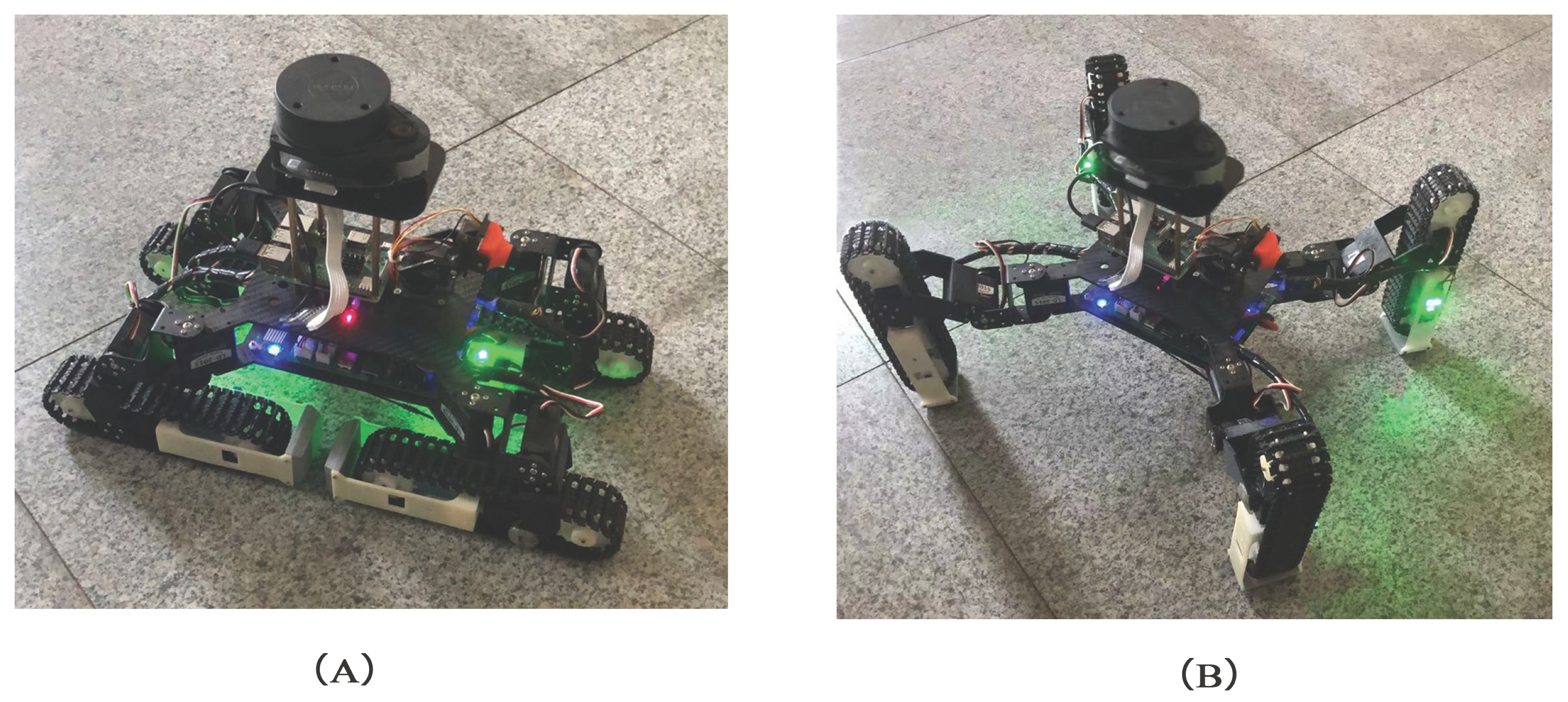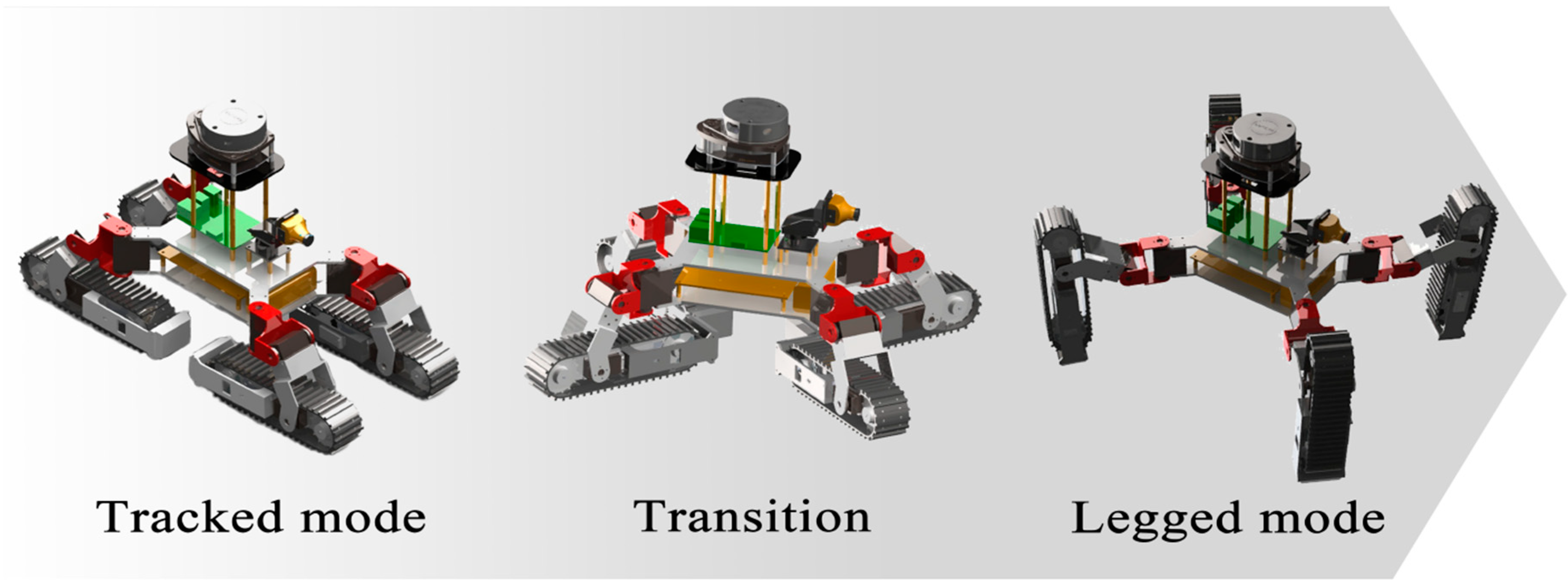3.1.1. Tracked Mode Movement Control
Because the four tracked legs are directional, TALBOT can turn around by changing the direction of the tracked leg feet. However, this method has too much load on the servos, so the robot’s movement control is carried out by the method of differential speed on both sides of the tracks. When the speeds of the tracks on both sides are different, TALBOT turns to the slower side. Using this method, the turning radius can be 0, which achieves the effect of turning in place. The speed of the tracked feet on the left and right sides is
and
, respectively, and the overall speed of TALBOT is
TALBOT has four driving tracked feet; the diameter of the wheel in the tracked foot is
d; the photoelectric encoder is
p line/revolution; the pulse frequencies output by the photoelectric encoders of the left and right driving wheels are
and
, respectively; and the linear velocity of the wheel is
The distance between the left and right tracked feet is
L, and the turning radius of the left and right tracked feet of TALBOT are
and
, respectively; So
If the robot moves from state
to state
, the angle variation value
, the arc length
through which the robot moves in circular motion, and the corresponding chord length
can be obtained, respectively:
From this, the state change from
n to
n + 1 is
The equation of motion is
3.1.2. Legged Mode Movement Control
Gait refers to the movement of a foot-type robot in which one leg lifts and falls in accordance with certain rules in coordination to realize the body displacement in space. The gait plays a vital role in the movement of the legged robot. During the movement of TALBOT in the legged mode, the leg includes two movement states: the stance phase and the swing phase. The swing phase refers to the process in which the leg moves forward to complete a forward motion, while the support phase is the process in which the leg remains stationary to maintain the stability.
When the traveling speed is slow, each step of the quadruped animal is in a relatively stable three-legged support state, such as a tortoise. This movement pattern is called walk gait. The faster ones are the trot and pace gaits. In order to ensure the smooth operation of TALBOT, only the slower walk and trot gaits were studied.
The defined gait period
T is the time required for all legs of TALBOT to act as a swinging leg, that is, the time required for a swinging leg to act as swinging leg again. The ratio of the time a leg is used as a supporting leg in a walking cycle to the cycle time
T is defined as the support factor
, as shown in equation:
where
is the duration of the stance leg in a period
T.
is the duration of the swing leg in a period
T.
T =
+
is the time of one gait cycle of TALBOT.
It can be seen from Formula (
8) that the value of
is between 0 and 1. According to the value of
, the gait of TALBOT is also different.
- (1)
When , the number of stance legs of the TALBOT was always less than 2, and sometimes the number of stance legs was 0, which was an unstable gait. Although the speed of TALBOT under this gait was the fastest, the stability was the worst
- (2)
When = , the time of the swing phase is equal to the time of the stance phase at this time. During the whole movement, TALBOT always keeps two legs in a stance state to maintain its own stable state, and the other two legs in a swing state can maintain its own forward speed. This gait is called a trot or pace gait.
- (3)
When , TALBOT is in the transition state two-legged gait and three-legged gait.
- (4)
When = , TALBOT will have three legs in the stance state and the other leg in the swinging state. Compared with the two-leg gait, the number of supporting legs in this state is more, so it is more stable in the process of walking, but the forward speed in the process of movement will be slower. This state is called walk gait.
- (5)
When , three legs of TALBOT are in the stance state, and the other leg is in the transition state between the swing state and the stance state.
- (6)
When = 1, all four legs of TALBOT are in a stance state, that is, a static state
TALBOT uses the hopf oscillator as the core to establish the motion control model of the CPG. The hopf oscillator is a harmonic oscillator with fewer parameters and a clear physical meaning. Each parameter individually affects the performance of the oscillator and is convenient for tuning. The amplitude, frequency and phase of the output signal are easy to control and can be used to control the walking gait. Its mathematical expression is
where
x and
y are the state variables of the oscillator, that is, the output of the oscillator.
is the convergence rate coefficient, which is used to control the convergence rate of the limit cycle and is a normal number. The larger
is, the faster the limit cycle can converge.
is the square of oscillator amplitude;
is the frequency of the oscillator
Among them:
is the stance phase frequency;
is the swing phase frequency;
a is a larger normal number, which determines the conversion speed of
between
and
; and
is the support factor. When
=
, the swing time is the same as the stance time. By changing the value of
, the swing time and the stance time can be adjusted. Taking
=
,
a = 100,
= 3
,
= 1, the output curve of the oscillator state variable
x is shown in
Figure 5A. Taking
=
, it can be seen from
Figure 5B that the swing time is different from the stance time.
To realize the coordinated movement between the legs, it is necessary to construct a CPG network, through the mutual coupling of multiple oscillators, to ensure the synchronization and coordination of the movement. Generally, a common method to generate gait is to use 12 oscillators to form a fully symmetrical CPG network. Each oscillator corresponds to a robot joint, and the joints are coupled to each other to form a phase difference. So, the CPG network is complicated, and parameter adjustment is difficult. Aiming at the characteristics of the quadruped TALBOT’s gait, the CPG coupling model in this study adopts a hierarchical model. As shown in
Figure 6, the upper layer of the CPG network is the coupling between the legs, and the network connection mode is a ring network connection, which only requires four oscillators. The bottom layer is the CPG intra-leg coupling, which is composed of hip joints and corresponding knee joints. The ankle joint control signal is realized by the knee-ankle mapping function.
Let the rotation angles of the hip, knee, and ankle joints be
,
, and
, respectively. The rotation ranges of the hip, knee, and ankle joints are as shown in the
Table 1, and the mapping function between them and the output curve of the oscillator is
Among them:
is the mapping coefficient of the hip joint;
and
are the mapping coefficients of the knee joint; and
is the mapping coefficient of the ankle joint, which is used to adjust the amplitude of the joint control signal. Combining the mechanical structure and parameters of the robot in this study, take
= 0.5,
=
,
=
,
= 0,
= 0,
= 0,
= 0.7, and
= −
and obtain the joint angle control signals of each joint as shown in
Figure 7.
The oscillators that control the four legs of the TALBOT are coupled with each other and continuously output joint rotation control signals, so that TALBOT can move in various gaits. This section uses the ring-type coupling network topology to describe the phase coupling relationship between the output signals of each oscillator model. Combining Formulas (
9) and (
10), its mathematical model is
Among them:
is the coupling strength parameter between the two oscillators. The value of
will affect the connection between the rising and falling sections of the output curve. In order to prevent glitches in the output curve and cause chattering in the system, the value of
should not be too high. TALBOT takes
= 0.6;
is the phase difference between oscillator
i and
j, that is,
=
−
; the definition of other parameters is consistent with Formulas (
9) and (
10).
When TALBOT walks in a trot gait, its legs are divided into legs LF, RR, and legs RF, LR. The two legs of the same group have the same phase, and the two legs that are not in the same group have a phase difference of
. The coupling network is shown in
Figure 8B; when walking in a walk gait, each leg of the robot is a group; enters the swing phase in the order of LF, RF, LR, RR; and the phase difference between the two legs of the adjacent group is
; its ring-shaped coupling network is as shown in
Figure 8A.
Set the stance factor
= 0.5 and 0.75 for the walk and trot gaits, respectively, and set the other parameters according to the relevant parameters of TALBOT and the output curve of the hip joint oscillator as shown in the
Figure 9A,B, respectively.
According to Formula (
11), the angles of the ankle joint are obtained through the mapping of the knee joint, so as to obtain the rotation angle of each joint of the robot in the walk and trot gait, as shown in
Figure 10 and
Figure 11. In addition, by adjusting the amplitude and the positive or the negative of the output curve of the oscillator, TALBOT can turn around and back up.

























